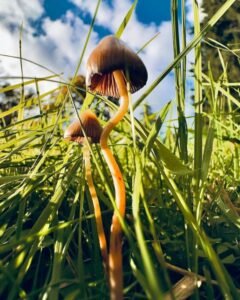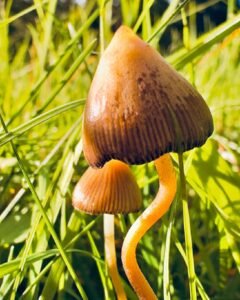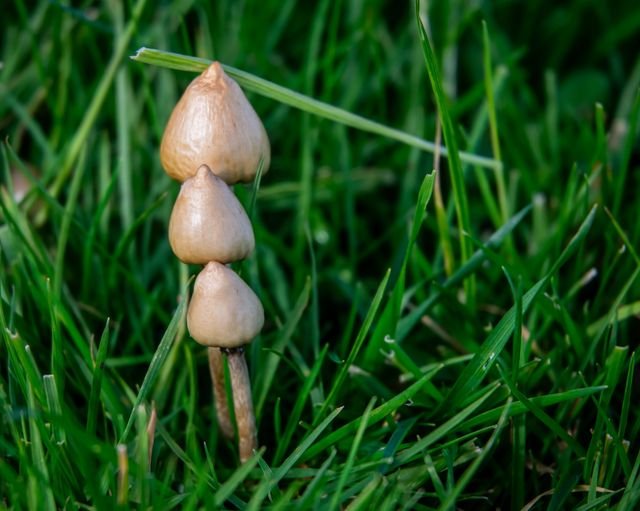General information:Common names: Psilocybe semi-lancéoléClass: Agaricomycetes Familly: Hymenogastraceae Genus: Psilocybe Order: Agaricales Phylum: Basidiomycota Usable: Hallucinogenic |
Psilocybe semilanceata physical characteristics
Psilocybe semilanceata, commonly known as the liberty cap, is a species of psychedelic mushroom. Here are some physical characteristics of Psilocybe semilanceata:
Cap: The cap of Psilocybe semilanceata is conical or bell-shaped when young, becoming more convex with age. It typically ranges from 0.5 to 2.5 centimeters in diameter, with a distinctive nipple-like protrusion (umbo) on the top. The cap color can vary from light brown to yellowish or olive-green.
Gills: The gills of Psilocybe semilanceata are attached to the stem and are closely spaced. Initially, the gills are pale grayish in color, but as the mushroom matures, they turn dark purplish-brown to black. The gills are typically somewhat mottled.
Stem: The stem of Psilocybe semilanceata is slender and elongated, ranging from 2 to 9 centimeters in length. It is often curved or twisted, and its color can vary from pale yellowish to whitish or light brown. The stem is typically smooth and has a fibrous texture.
Spore Print: The spore print of Psilocybe semilanceata is dark purplish-brown.
Flesh: The flesh of Psilocybe semilanceata is thin and typically whitish to pale brownish in color.
Psilocybe semilanceata edibility
Psilocybe semilanceata, commonly known as the liberty cap, is a psychedelic mushroom that contains the compound psilocybin. While psilocybin mushrooms are used for their psychoactive effects, they are not typically consumed for their edibility. Psilocybin mushrooms, including Psilocybe semilanceata, are generally not considered edible in the traditional sense. It’s important to note that the consumption of psilocybin mushrooms is subject to legal restrictions in many countries and can carry legal and health risks. Psilocybin mushrooms should only be used in a controlled and responsible manner, under the guidance of knowledgeable individuals, and in compliance with local laws and regulations.
Psilocybe semilanceata indentification
When identifying Psilocybe semilanceata, or the liberty cap mushroom, it is important to consider several key characteristics:
Cap: The cap of Psilocybe semilanceata is typically conical or bell-shaped when young, becoming more convex with age. It typically ranges from 0.5 to 2.5 centimeters in diameter and has a distinctive nipple-like protrusion (umbo) on the top. The cap color can vary, ranging from light brown to yellowish or olive-green.
Gills: The gills of Psilocybe semilanceata are attached to the stem and are closely spaced. Initially, the gills are pale grayish in color, but as the mushroom matures, they turn dark purplish-brown to black. The gills are typically somewhat mottled.
Stem: The stem of Psilocybe semilanceata is slender and elongated, ranging from 2 to 9 centimeters in length. It is often curved or twisted and its color can vary from pale yellowish to whitish or light brown. The stem is typically smooth and has a fibrous texture.
Spore Print: Obtaining a spore print can be helpful for identification. The spore print of Psilocybe semilanceata is typically dark purplish-brown.
Habitat: Psilocybe semilanceata is commonly found in grassy areas, such as meadows, lawns, and pastures, especially those that have been grazed by animals. It often grows in association with grass or other herbaceous plants.
Psilocybe semilanceata habitat and frequency
Psilocybe semilanceata, commonly known as the liberty cap, has specific habitat preferences and can be found in certain regions. Here is some information regarding its habitat and frequency:
Habitat: Psilocybe semilanceata is commonly found in grassy areas, such as meadows, pastures, and lawns. It has a particular association with grass or other herbaceous plants. It often grows in areas that have been grazed by animals, as the spores can be spread through their droppings. The mycelium of Psilocybe semilanceata forms a symbiotic relationship with the roots of grasses.
Geographical Distribution: Psilocybe semilanceata is found in various regions around the world. It is known to occur in Europe, North America, parts of Asia, and some regions of Australia. Its distribution can vary within these areas, with more concentrated populations in certain regions.
Frequency: The frequency of Psilocybe semilanceata can vary depending on environmental conditions and specific locations. It is considered to be a widespread and fairly common species in its suitable habitats. However, its abundance can fluctuate from year to year and in different seasons.
Psilocybe semilanceata health benefits and using for medicine purposes
Psilocybe semilanceata, commonly known as the liberty cap, is primarily known for its psychoactive properties rather than its health benefits. The main active compounds in Psilocybe semilanceata are psilocybin and psilocin, which have hallucinogenic effects and interact with serotonin receptors in the brain.
While the use of psilocybin-containing mushrooms for therapeutic purposes is an area of ongoing research, it is important to note that their medicinal use is not yet widely established or approved in many countries. Clinical trials and studies are being conducted to investigate the potential therapeutic applications of psilocybin, including for conditions such as depression, anxiety, and post-traumatic stress disorder (PTSD). However, further research is needed to better understand the safety, efficacy, and appropriate usage guidelines.
It is crucial to approach the use of psilocybin-containing mushrooms, including Psilocybe semilanceata, with caution and under the guidance of trained professionals in controlled settings. The effects of these mushrooms can be unpredictable, and they may not be suitable for everyone. It is essential to prioritize safety, legal compliance, and personal well-being when considering the use of these substances.
Psilocybe semilanceata scientific research
Scientific research on Psilocybe semilanceata, or the liberty cap mushroom, has primarily focused on its psychoactive properties and potential therapeutic applications.
Psychoactive Properties: Several studies have investigated the psychoactive effects of Psilocybe semilanceata. For example, a study published in the Journal of Psychoactive Drugs in 2015 examined the subjective effects and cognitive functioning of participants after consuming Psilocybe semilanceata. The researchers found that the mushroom produced significant alterations in consciousness, including visual distortions, changes in perception, and emotional experiences.
Therapeutic Applications: Research on the therapeutic potential of psilocybin, the main psychoactive compound in Psilocybe semilanceata, has extended to various mental health conditions. A randomized controlled trial published in the New England Journal of Medicine in 2020 investigated the use of psilocybin-assisted therapy for treatment-resistant depression. Although this study did not specifically focus on Psilocybe semilanceata, it highlights the broader research on psilocybin’s therapeutic effects.
Chemical Analysis: Studies have also examined the chemical composition of Psilocybe semilanceata. For instance, a study published in the Journal of Chromatography A in 2007 analyzed the alkaloid content of Psilocybe semilanceata samples from different geographical locations. The researchers identified various psychoactive compounds, including psilocybin, psilocin, and baeocystin.
It is important to note that research on Psilocybe semilanceata and psilocybin is ongoing, and further studies are being conducted to explore its potential therapeutic applications, safety profiles, and mechanisms of action. It is advisable to rely on scientific literature and consult with professionals who are knowledgeable about psychedelic research for the most up-to-date and accurate information.
Psilocybe semilanceata psychoactive effects
Psilocybe semilanceata, commonly known as the liberty cap mushroom, is recognized for its psychoactive effects due to the presence of the compounds psilocybin and psilocin. These compounds interact with serotonin receptors in the brain, leading to alterations in perception, cognition, and mood.
Hallucinations: Psilocybin mushrooms can induce visual hallucinations, characterized by vivid and altered perceptions of colors, shapes, patterns, and textures. These hallucinations can range from mild visual distortions to more profound visual experiences.
Altered Perception: Users often report a distorted perception of time, space, and the self. They may perceive familiar objects or surroundings as unfamiliar or experience a sense of interconnectedness with their environment.
Emotional Effects: Psilocybe semilanceata can evoke a wide range of emotions, including euphoria, introspection, empathy, and profound feelings of interconnectedness. Users may also experience mood swings and heightened emotional sensitivity.
Cognitive Effects: Psilocybin mushrooms can induce changes in thinking patterns and cognitive processes. Users may experience enhanced creativity, increased introspection, and altered thought processes. Some users report a sense of expanded consciousness or profound insights during their psychedelic experiences.
Spiritual and Mystical Experiences: Psilocybe semilanceata has been associated with profound spiritual or mystical experiences, characterized by a sense of awe, transcendence, and connection to something greater than oneself.
The psychoactive effects of Psilocybe semilanceata can vary from person to person and depend on several factors, including dosage, individual susceptibility, mindset, and the setting in which the mushrooms are consumed. These effects can be profound and potentially intense, and it is crucial to approach their use with caution, respect, and proper preparation.
Psilocybe semilanceata other names
Psilocybe semilanceata, commonly known as the liberty cap, does not have a wide range of alternative common names including:
Magic Cap
Witch’s Hat
Conical Cap
Cone Cap
Liberty Bell
In other languages:
Spanish: Seta de San Jorge, Seta de la libertad
French: Psilocybe demi-lanceolé
Portuguese: Chapéu da liberdade
Italian: Cappello della libertà
German: Spitzkegeliger Kahlkopf
Dutch: Puntig kaalkopje
Russian: Shapochka svobody


